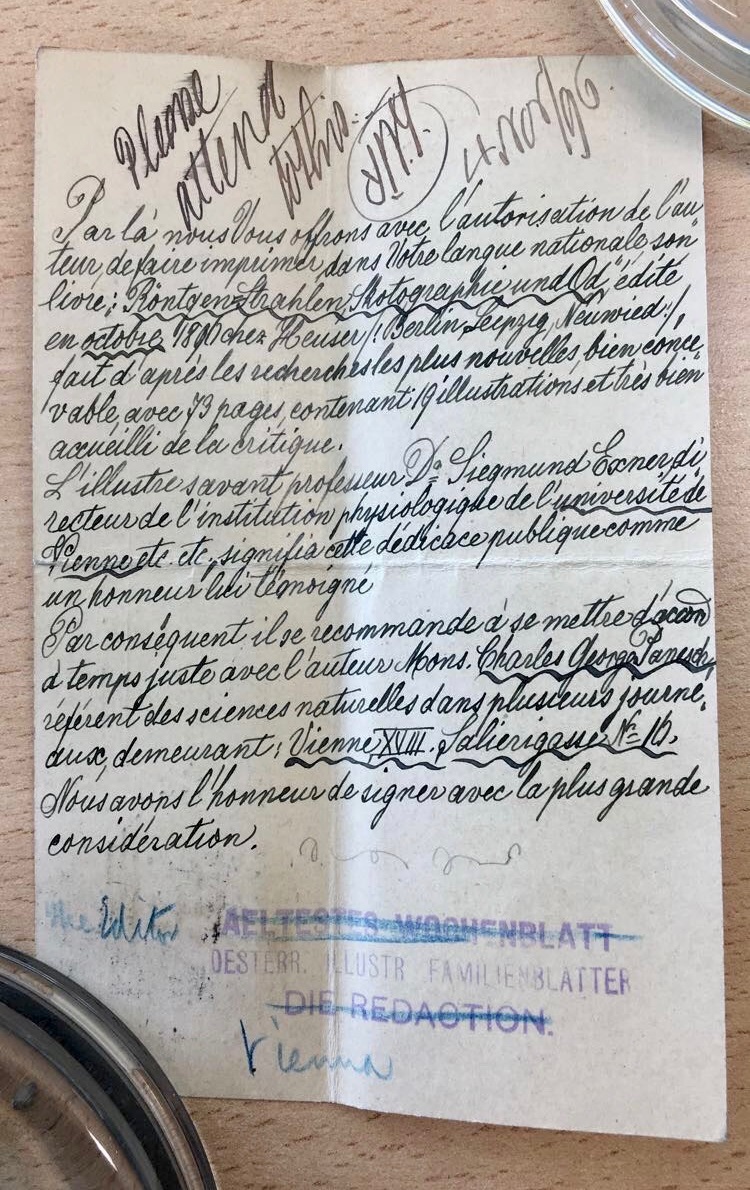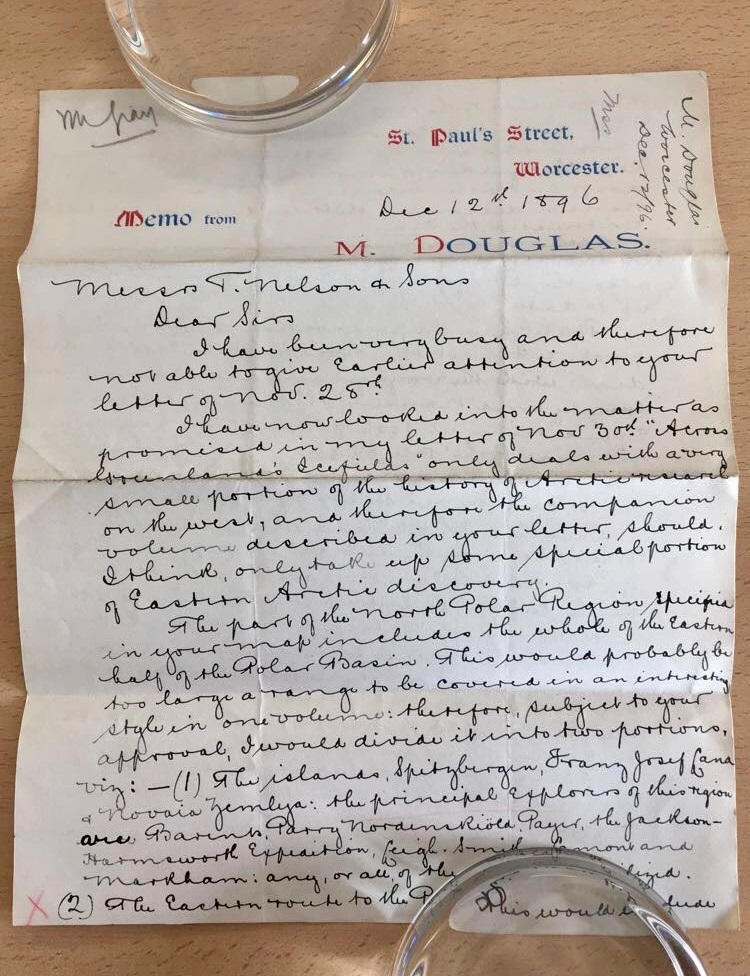Cataloguing the correspondence of Thomas Nelson & Sons (cont.)
Our intern Isabella has now finished her 10-week placement at the CRC, during which she was box-listing part of the records of Thomas Nelson & Sons Ltd. Her thoroughness and fine attention to details made her perfect for the job. Luckily for us, Isabella enjoyed her placement so much that she decided to keep working on the collection as a volunteer! We are delighted that she is going to keep doing excellent work on this great collection. Here are a few more of her great finds.

Isabella working in the CRC reading room.
1. Jane Borthwick Letter: While every other letter in this bundle is written in black or dark blue ink, with edits often made with red ink, Jane Borthwick writes a letter here in an aesthetically appealing purple ink. The letter concerns a manuscript which she was enlisted to read, review, and recommend for either publication or rejection. Unfortunately for the author, Ms. Borthwick found the piece too dull to be printed. On the back of the letter there is slight evidence of handling where several ink stained fingers held the letter. While the marks are slight and it cannot be determined if these are the product of Jane herself, an employee of Nelson & Sons or of a later cataloguer or archivist, it stands as evidence of this letters connection to the people that have interacted with it, carrying its handling history on its surface. 1. Jane Borthwick’s letter
1. Jane Borthwick’s letter
2. R. Anderson Letter: A letter from R. Anderson displaying discoloration of paper, dust and dirt – Some of the correspondence we are working to catalogue requires light conservation methods before we can return them to storage. In this letter from an R. Anderson, one side shows how protected and covered paper ages as that side has been stored firmly pressed against another letter, while the other side reveals how long-term exposure to the elements of stacks can fade, damaged and color the paper. In order to attempt to combat this issue a small dry sponge is used to wipe away what dirt or dust can be wiped away, however, due to the age of the ink on the paper we must be careful not to take any of the ink off the page itself. This then becomes a conundrum of whether to maintain the precision of the ink or to treat the residue before it becomes a larger and more expensive issue.

2. R. Anderson’s letter
3. French Postcard: Here we have a postcard from Vienna written entirely in French. Unfortunately, our cataloguer does not read French and so help was requested from a fellow student from the Book History and Material Culture course, Eleanor Cambridge, as well as the cataloguer’s supervisor and resident Archivist with the Center for Research and Collections, Aline Brodin. The emersion of this postcard from the collection allowed for cooperation between postgraduates as well as Archivists to engage in a multi-national approach to decipher another element of the archive. This opportunity not only demonstrates the way archivists and cataloguers often work in tandem in order to contextualize information and collections, but it further speaks to the multi-national nature and reputation of Nelson & Sons.

3. French postcard
4. J. A. Bains Letter: Pictured here is part of a collection of nine letters sent from one J. A. Bains on highly personalized stationery decorated with fastidiously carved print images on one side. Despite the intricacy of the prints on the stationary, their appearance is not entirely a surprise as if you look to the right-hand side of the image you will see that Mr. Bains was a bookseller as well as a Stationer. Mr. Bains interactions with Nelson & Sons was such that he had been writing a biography on the Norwegian explorer Fridtjof Nansen and was very determined to see his piece published with their company alone. This sentiment was made plain to Mr. Brown, a manager at the company, in the final line of Mr. Bains letter from May 12th, 1896 writing, ‘I am determined that Messrs. T. Nelson & Sons shall publish it – even if I have to wait for months or years! I have spent too much labor (even if amateur) too much money and wandered too many miles to gather information to let it fall through.’ Bains was a jovial correspondent, often using exclamation points in his letters, reasserting that he would have no one else publish his work but Nelson and Sons, and on two occasions joking that if Nansen, who was on expedition at the time of these letters, did not return then his book would be the first biography published and probably a roaring success. Unfortunately, Mr. Brown did not return his enthusiasm as he rejected the opportunity to publish the work, multiple times, and so Mr. Bains took his biography to Walter Scott Publishing Co. Ltd. and the book was published in 1897.

4. J. A. Bains’s letter
5. Sophia Caulfield and Audrey Curtis Letters: Many of the manuscripts sent to Nelson & Sons were full of differing content and came from a variety of people throughout a number of countries. Audrey Curtis and Sophia Caulfield were two of those authors. Ms. Curtis submitted her manuscript of ‘a tale of the Huguenot persecution in France about the date 1685’ while Ms. Caulfield wrote about ‘little-known curiosities in the department of Natural History’ of London. Each woman worked on historical and amateur scientific novels. Curtis herself had previously been published by the National Society for her short story entitled “The Artist of Crooked Alley” as well as for her story for children titled “Little Miss Curlylocks”. Each woman was a fairly accomplished author by the time they came across Nelson & Sons for their publications with Ms. Caulfield identifying herself as one of the original writers for a popular magazine aimed at young women interested in science and politics. As well Ms. Caulfield included a written resume with her manuscript to Nelson & Sons of all that she had worked on which included compiling a dictionary of needlework, textiles, and lace, as well as editing magazine articles, and her latest book which had been shown at the Chicago “World’s Fair” as well as the ‘Great Paris Exposition’.

5. Audrey Curtis’s Letter
6. Rev. F. Docker Letter: The Reverend F. Docker, pictured here, was a religious short story author who sent several stories for potential publication to Nelson & Sons in 1896. Along with his letter and his manuscripts he included a newspaper clipping from The Christian Age newspaper bearing one of the stories which he had written as well as his picture. If you peer at the heading of the paper, you will see that it is identified as No. 1,268. -Vol. XLVIII.-26. and was published in ‘London, Wednesday, December 25, 1895’ meaning that the story Reverend Docker submitted to the publishers was in fact a Christmas installment.

6. Rev. F. Docker’s Letter
7. Miss M. Douglas Letter: Here we see another example of Nelson & Sons enlisting the help of an expert for practical scientific publications. M. Douglas was a woman who worked with Nelson & Sons when producing a new book about Arctic Exploration. She was the designated reader and critic for the configuration and aesthetic design of the maps illustrated in the book. Unfortunately, this letter does not give the reader any more background as to her work but rather it does prove she showed a high proficiency for spatial relations, math, and geography in order to conceptualize and stylize maps for the Arctic which in 1896 was still a relatively unknown climate. In her letter here she shows a high understanding of Polar currents as well as a strong familiarity with the literary histories of Arctic Exploration.

7. Miss M. Douglas’s letter
8. Ernest Ingersoll Book Submission: In 1896 Ernest Ingersoll submitted to Nelson & Sons his story entitled “A Railway Stowaway” which had previously been published in the United States by the well-known publishers of Harper & Brothers. In his letter Mr. Ingersoll offers Nelson & Sons ‘all rights outside the United States’ to the publication. While many authors include a full manuscript along with their letters, which they either request to be returned if they are rejected for publication, a gamble if the author has not written out or commissioned printed copies, Mr. Ingersoll included a small pocket copy of his story which was printed in the style of the Harper Collins 1882 edition. This particular copy was hand bound as you can see from the string threaded through the center pages and came complete with illustrations. The size of the copy enabled it to stay with the letter in this case, instead of the manuscript being returned or archived in a different location within the collection. This inclusion allowed us to not only understand the background of this submitted manuscript but also to collect the priority piece of knowledge that Nelson & Sons were offered sole rights to this piece for every publication outside of the United States. Unfortunately, Nelson & Sons decided to reject the offer. However, Mr. Ingersoll did not give up entirely and instead sent them a copy of one of his other stories entitled “The Ice Queen” which had been well received in the United States and which Harper & Brothers were willing to negotiate on copyright purchasing and illustrations expenses. While the last photo in the below series is not included in any copy of Ingersoll’s printed work, it is a wonderfully interesting example of marginalia which mimics medieval style. Referred to as a manicula, the hand design which was used to draw attention to specific passages, is used by Ingersoll here to identify the final paragraph of his letter.

8a. Ernest Ingersoll

8b. Ernest Ingersoll

8c. Ernest Ingersoll

8d. Ernest Ingersoll – manicula